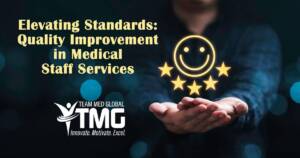 Picture a vast, intricate web, each strand carefully woven to support the whole. In this web, every touchpoint between practitioners and patients is connected, and at the center are the Medical Services Professionals (MSPs), quietly ensuring that the network runs smoothly. When one strand falters—whether it’s a delay in credentialing or enrollment, a misstep in privileging, or a gap in licensure—it can ripple across the entire system. Integrating Quality Improvement (QI) initiatives into these processes allows MSPs to strengthen their department’s contribution to the healthcare web, ensuring that every connection holds strong and the system performs at its best.
Picture a vast, intricate web, each strand carefully woven to support the whole. In this web, every touchpoint between practitioners and patients is connected, and at the center are the Medical Services Professionals (MSPs), quietly ensuring that the network runs smoothly. When one strand falters—whether it’s a delay in credentialing or enrollment, a misstep in privileging, or a gap in licensure—it can ripple across the entire system. Integrating Quality Improvement (QI) initiatives into these processes allows MSPs to strengthen their department’s contribution to the healthcare web, ensuring that every connection holds strong and the system performs at its best.
Identifying Bottlenecks with Workflow Audits
One of the most straightforward ways MSPs can spearhead QI efforts is by conducting workflow audits. Taking a close look at every step in the credentialing, privileging, provider enrollment, or licensing process can reveal inefficiencies or unnecessary steps that slow down the department’s productivity. For instance, tracking how long it takes to receive a completed application from a practitioner or identifying repetitive steps in verifying credentials can highlight areas where improvements are needed.
Once bottlenecks are identified, MSPs can propose practical solutions. For example, if there is a recurring delay in receiving certain documentation, MSPs can develop clearer communication protocols or set up reminders to ensure those documents are submitted on time. Even small tweaks to the workflow can have a big impact on reducing delays and increasing overall efficiency.
Implementing Process Checklists to Reduce Errors
A simple but effective QI strategy is the introduction of detailed process checklists. Checklists ensure that every credentialing and privileging step is completed without missing critical details. For example, when reviewing applications for reappointment, having a checklist that covers required documentation, license verification, and peer references can help reduce the risk of oversight.
In addition to ensuring consistency, checklists also make it easier to train new MSP staff members and maintain accountability. When everyone follows the same structured process, the likelihood of errors diminishes, and it becomes easier to identify and correct issues when they arise.
Peer Review and Collaborative Feedback
Another fresh approach MSPs can take is encouraging peer review and feedback within their department. While peer review is often associated with practitioner performance, it can be a powerful QI tool for MSP operations as well. By establishing a collaborative environment where team members regularly review each other’s work—such as reviewing completed credentialing files before final submission—MSPs can catch potential mistakes or inconsistencies early.
Additionally, periodic team discussions about what’s working well and where improvements can be made foster an open environment for continuous improvement. This kind of internal feedback loop allows for small adjustments to processes that enhance overall accuracy and performance.
Streamlining Communication with Practitioners
MSPs are often the main point of contact for practitioners during the licensing, credentialing, and enrollment processes. Miscommunication or unclear instructions can lead to delays or incomplete applications, which then disrupt workflows. One effective QI initiative is improving how information is conveyed to practitioners. This could involve drafting clearer, standardized templates for communication or providing step-by-step guidance for submitting required materials.
MSPs can also create FAQs or quick-reference guides that help practitioners understand what’s expected from them, reducing the number of back-and-forth inquiries. Clear communication not only speeds up processes but also reduces frustration for both MSPs and practitioners.
Tracking and Monitoring Key Metrics
While MSPs may not be able to implement full-scale data analytics tools, they can still track key performance metrics manually or using simple tools like spreadsheets. Monitoring metrics such as the average time to complete credentialing, the number of incomplete applications, or the rate of delayed submissions provides valuable insights into the department’s performance.
Once these metrics are tracked over time, MSPs can present data-driven suggestions for improvement to department leadership. For example, if data reveals that receipt of peer recommendations is consistently causing delays, MSPs can recommend a software platform to automate that process or provide more timely follow-up to those contacts to improve turnaround time.
Enhancing Cross-Departmental Collaboration
QI efforts also benefit from better collaboration between the MSP department and other key stakeholders, such as the medical executive committee, human resources, and clinical departments. MSPs can initiate regular check-ins or collaborative meetings to align expectations, address bottlenecks, and ensure that credentialing, privileging, and enrollment processes are moving forward smoothly.
This cross-departmental collaboration ensures that everyone is on the same page and minimizes delays caused by misaligned priorities. Additionally, it reinforces the important role that MSPs play in the overall functioning of the healthcare facility, making it easier to advocate for support when QI projects need additional resources or attention.
MSPs are uniquely positioned to drive quality improvement within their departments, taking the lead in identifying inefficiencies, improving communication, tracking performance metrics, and fostering a culture of collaboration. By integrating QI initiatives into their daily operations, MSPs ensure that their work is not only efficient but also aligned with the highest standards of quality, ultimately contributing to the smooth functioning of the entire healthcare organization.

